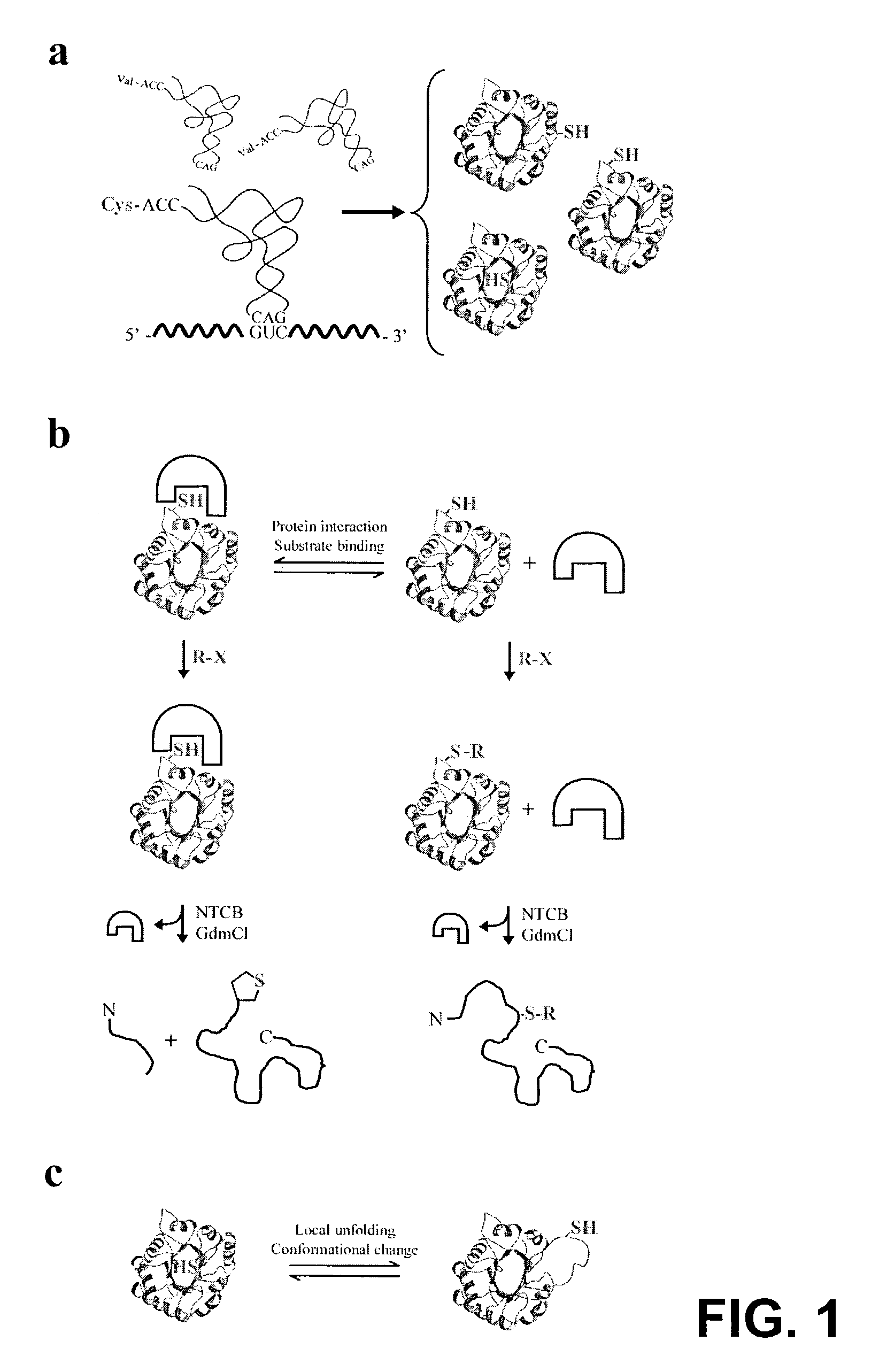Methods for structural analysis of proteins
- Summary
- Abstract
- Description
- Claims
- Application Information
AI Technical Summary
Benefits of technology
Problems solved by technology
Method used
Image
Examples
example 1
Misincorporation of Cysteine for Protein Footprinting
[0225]A cysteine-free variant of yeast triosephosphate isomerase (TIM) was used as a model system to investigate the MPAX technique. TIM is a dimeric (β / α)8 barrel protein. The TIM construct used here includes a C-terminal protein kinase A tag to allow labeling with radioactive phosphate, and an N-terminal 6×His tag on a 30 amino acid linker for purification. This linker shifts the full-length, 290-residue protein away from the fainter cleavage products during gel electrophoresis.
[0226]The misincorporation of cysteine at specific amino acid positions was first verified by expressing TIM in the presence or absence of a series of cysteine misincorporator tRNAs. Cleavage of TIM by NTCB was observed only when TIM was co-expressed with a misincorporator tRNA (FIG. 3, panel A). FIG. 3, panel A is an autoradiograph of an electrophoretic gel which shows that the TIM protein was expressed in the presence of the indicated misincorporator tR...
example 2
Mapping Binding Sites
[0229]Strategies for chemically mapping protein interaction sites fall into three broad categories: interference, crosslinking and protection (Creighton, T. E., Proteins (W. H. Freeman and Company, New York, 1993) pp. 333-334). Interference is based on scanning mutagenesis of a protein. If a residue substitution interferes with a physical interaction, it is inferred that the residue plays a role in binding. In the chemical crosslinking approach, residues that participate in crosslinks are identified, and the existence of the crosslink implies spatial proximity to the binding partner. Finally, protection methods are based on chemical modification of a protein in the presence and absence of a binding partner. Binding sites are identified as residues protected from modification by the presence of the partner. The three techniques provide distinct and complementary information. For example, protection and interference analysis identifies regions of a protein that un...
example 3
Mapping Protein Topology
[0234]Current de novo protein structure prediction algorithms yield multiple reasonable structural models given an input sequence. The inclusion of sparse experimental NMR data in the prediction process significantly improves the accuracy and convergence of the computed models (Bowers, P. M., et. al., J. Biomolecular NMR 18:311, 2000). To address the possibility that data derived from the MPAX method might also be useful for guiding computational structure prediction, the inventors investigated whether the MPAX method could be used to map protein topology.
[0235]The alkylation rates of cysteine residues misincorporated at 61 positions in the TIM sequence were measured. Solvent exposed residues are expected to alkylate more rapidly than buried residues, and thus alkylation rates should be useful for assigning sequence positions to interior or exterior environments. The observed alkylation rates can be interpreted using a kinetic model derived from hydrogen exch...
PUM
| Property | Measurement | Unit |
|---|---|---|
| Tertiary structure | aaaaa | aaaaa |
| Stability | aaaaa | aaaaa |
Abstract
Description
Claims
Application Information
 Login to View More
Login to View More - R&D
- Intellectual Property
- Life Sciences
- Materials
- Tech Scout
- Unparalleled Data Quality
- Higher Quality Content
- 60% Fewer Hallucinations
Browse by: Latest US Patents, China's latest patents, Technical Efficacy Thesaurus, Application Domain, Technology Topic, Popular Technical Reports.
© 2025 PatSnap. All rights reserved.Legal|Privacy policy|Modern Slavery Act Transparency Statement|Sitemap|About US| Contact US: help@patsnap.com



